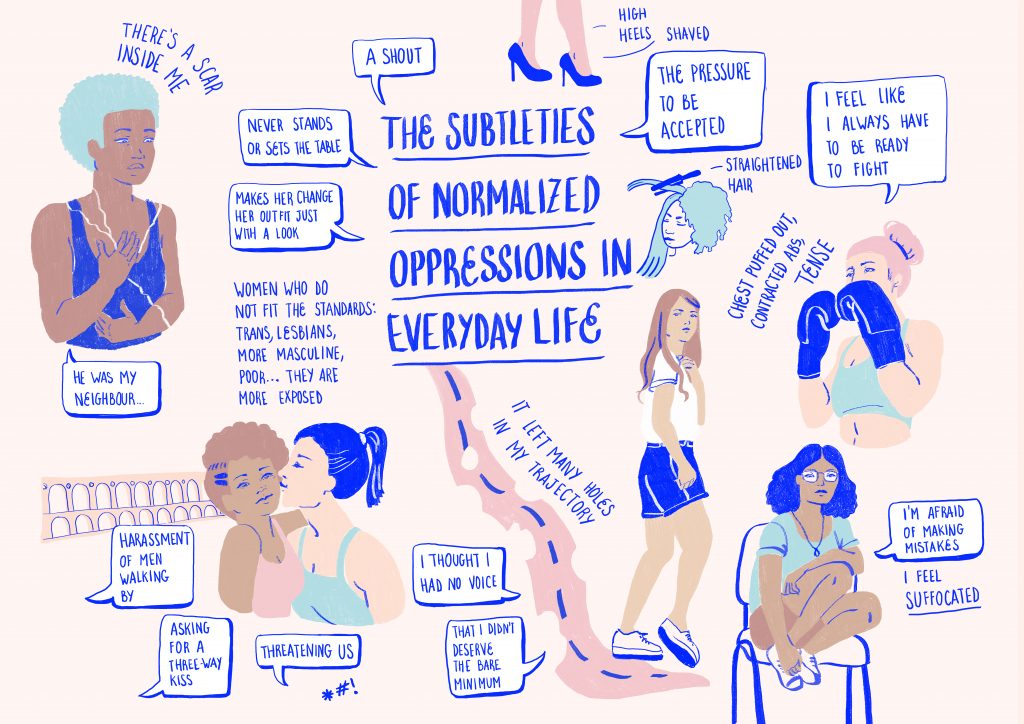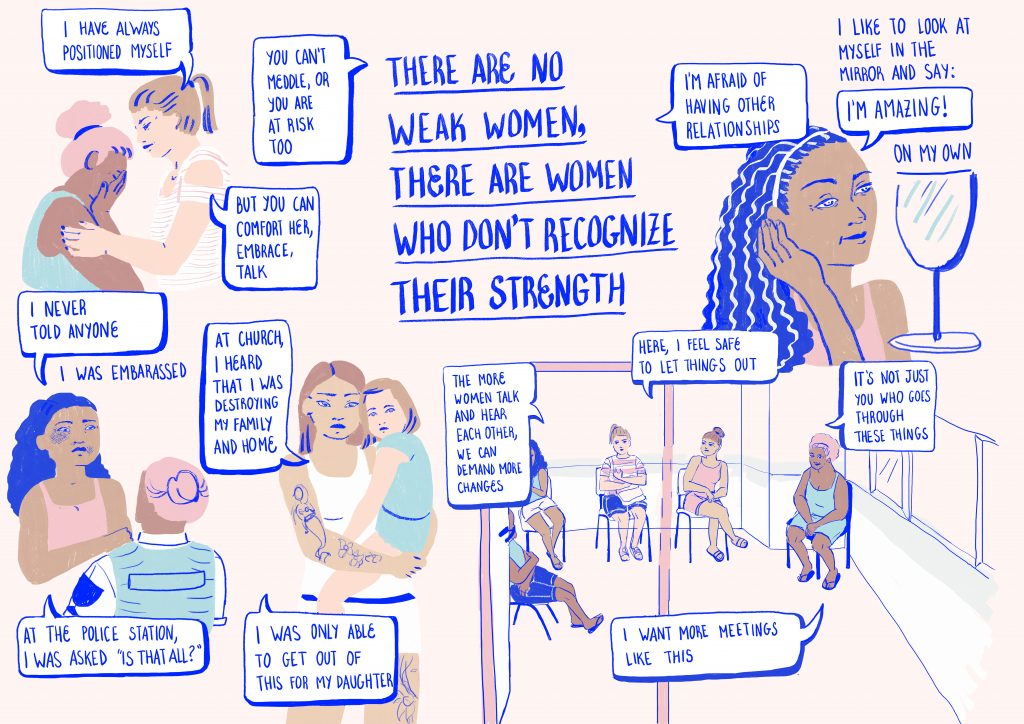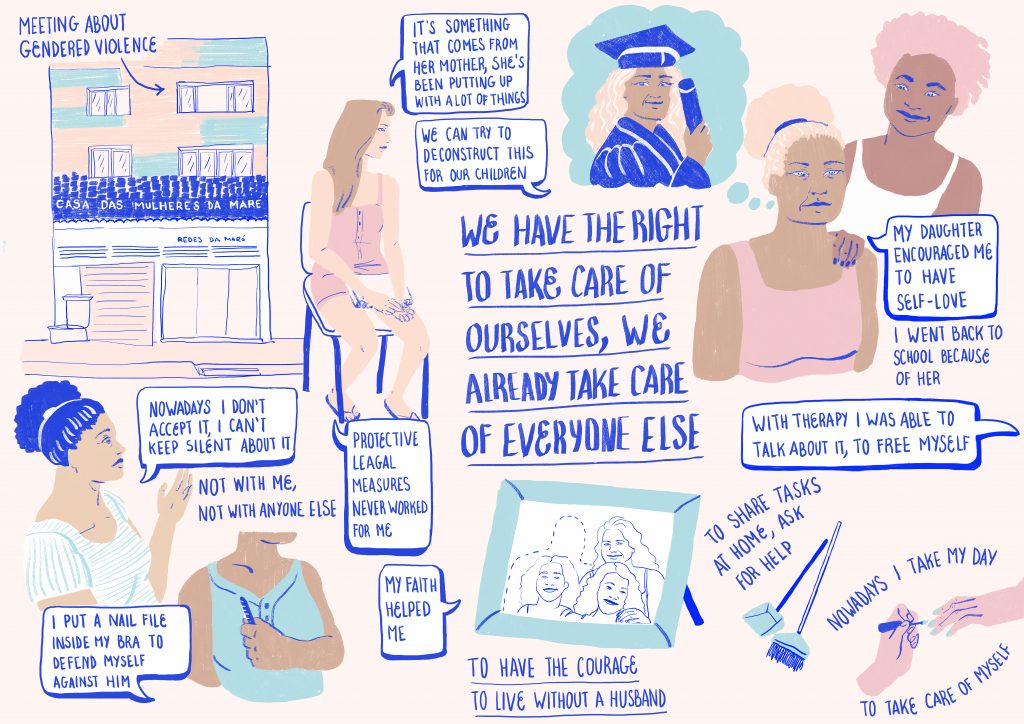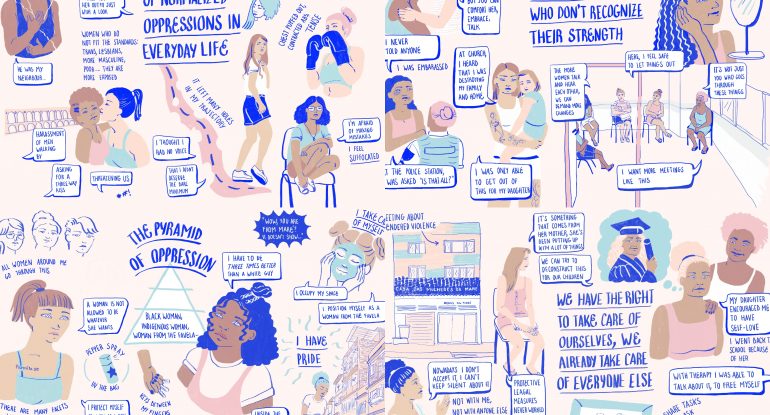Focus groups and creativity for understanding gender-based violence against women
Blog Series: Methodological engagements for understanding violence against women and girls in cities
* by Cathy McIlwaine & Moniza Rizzini Ansari
Exploring the multi-layered and intersectional complexity of gender-based violence against women in contexts of poverty and urban armed violence is no simple task. It requires interdisciplinary and multi-method approaches to capture the multiple forms of direct and indirect violence that occur and the pervasive ways they are embodied in women’s everyday lives.
The challenge is even greater if the investigation is ethically committed to acknowledging women’s agency in global peripheries, as protagonists in resisting violence and building dignity. Traditional social sciences methods are often insufficient to capture all the nuanced ways that women develop individual, collective and creative strategies to cope with and resist gendered violence.
Alternative forms of deepening understanding are essential and much can be learned from the use of the arts in creative, visual and embodied ways around intractable issues such as gendered violence. More than alternative ways of disseminating research, arts-based methods can be effective in sensing and understanding multiplicity and complexity in ways that the written word simply cannot. They are particularly useful in capturing and documenting sensitive elements often impossible to grasp from reports, fieldnotes and transcripts.
The project Resisting Violence, Creating Dignity engages with many such arts-based research strategies. One of these combines the traditional tools of group interviews, or focus groups, with creative forms of visual documentation through working with an artist. A key aspect of our research in Maré, Rio de Janeiro, was to conduct five focus groups with 27 women who had previously been interviewed about their experiences of gendered violence and the ways in which they developed strategies and mechanisms to cope with it and challenge it through forms of resistance. While we recorded and transcribed the discussions, we were also keen to capture them in ways that could communicate the dynamics of the encounters both visually and affectively. Clearly the use of photography was inappropriate given assurances of anonymity which is why we decided to work with a local artist, Mila de Choch (who worked in 4 of the 5 focus groups sessions conducted by the researchers Julia Gonçalves Leal and Fernanda Andrade Vieira at Casa das Mulheres).
As part of this interdisciplinary and methodological encounter, Mila developed a series of creative illustrations to register the subjective and sensitive elements of the discussions (such as affects, attitudes, and atmosphere) that would otherwise be missed. The intricate and sophisticated level of analysis enabled by such illustrations is evident. The benefits are all the more so significant in times of COVID-19, where face to face research activities have been so deeply affected. While of course, the drawbacks are that these reflect Mila’s interpretations of the discussions, the key themes align very closely with those that arose through analysis of the transcripts.
Figure 1: The subtleties of normalized oppressions in everyday life (with 5 women who expressed resistance to violence with corporal activities or body awareness)

Figure 1 shows the artistic observation of a group interview that focused on what they called the subtleties of normalized oppressions in everyday life. These words were used by participants in a group formed by 5 women who expressed forms of resistance to violence with corporal activities or body awareness. Much can be learned about the embodiment of gendered violence and how resilience and dignity also permeate women’s bodies.
Figure 2 which focuses on the comment ‘there are no weak women, there are women who don’t recognise their strength’ captured the nuances of resistance to gendered violence among a group of 6 working women (women working outside of their households and community). Here, Mila drew the focus group discussion in a way to communicate women’s processes of shame and isolation in experiencing gendered violence, but also their high levels of awareness of the importance of empowerment and mutual support.
Figure 2: There are no weak women, there are women who don’t recognise their strength (with 6 women working outside of their households and/or community)

Figure 3: We have the right to take care of ourselves, we already take case of everyone else (with 5 women who are fully dedicated to their household)

Another important theme emerged in the third focus group shown in Figure 3. This discussion was undertaken with 5 women who are exclusively dedicated to their household and who expressed a preference not to leave their communities or homes as a way to escape gendered urban violence. The visual recording effectively captured the ambivalent dimensions of care and social reproduction that so deeply marks women’s lives in that women have the right to take care of themselves.
Figure 4: The Pyramid of Oppression (with 5 younger women who are vocal about feminist and racial perspectives on the social role of the ‘favela resident’)

The final focus group entailed discussions with 5 younger women who demonstrated having experienced a prior discursive and/or practical initiation with feminist and racial perspectives on the social role of the ‘favela resident’ (Figure 4). They were very vocal about the multiple layers in their ‘pyramid of oppression’ through which experiences of violence affect particular groups in distinctive ways. Intersectionality, however, was also discussed as a tool of resistance, in that pride and self-affirmation appeared as powerful politicised forms of coping and confronting gendered violence in innovative ways.
It is difficult to communicate experiences of and resistance to gendered violence in visual ways that remain ethical and effective. There are also always dangers of re-traumatising women survivors. Our work with a visual artist who was able to capture both the key themes and comments from the focus group discussions as well as the emotional dimensions of the conversations has proved insightful and important. Not only has Mila provided a visual account of the focus groups, but she has also enhanced understanding of the processes discussed.
